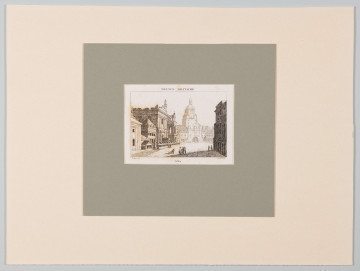
View of the Kraków Gate from the perspective of Krakowskie Przedmieście
1825
National Museum in Lublin
Part of the collection: Lubliniana. Painting views of Lublin and the Lublin Region (17th–early 20th c.)
Frederick Christopher Dietrich (1779-1847) came to Poland in 1817 at the behest of Stanisław Kostka Potocki, who commissioned him to make engravings for the Monumenta Regum Poloniae Cracoviensia. Dietrich decided to stay in Poland for good and founded an engraving workshop in Warsaw, which he ran together with his son Frederick Adolf. He specialized in the aquatint technique, initially practicing it as the only one in Poland. He made numerous architectural views of cities and towns as well as illustrations for publications. One of them is a depiction of Lublin published in the Guide du voyageur en Pologne et dans la République de Cracovie (A Guide for Travelers in Poland and the Republic of Krakow) by Józef Krasiński. The French version of the guide was published in 1820, and a year later it was published in Polish. The view of Lublin was included as one of ten prints of Krakow, Warsaw, Arkadia and Puławy. The publication belonged to the earliest nineteenth-century Polish guidebooks and was characterized by a modernly structured content, in which, apart from the characteristics of the most important monuments, information of practical importance was included: a chart of postal routes, routes between cities, locations of inns or a list of publications devoted to the history of the country. Lublin was described by Krasiński as one of the “largest and oldest cities in Poland”, which under the Jagiellonians “was considered the most beautiful in the Kingdom”. Dietrich's drawing is based on an earlier depiction of Krakowskie Przedmieście by Leon Urmowski. Changing only the staffage, Dietrich reproduced the compositional scheme and architectural structure of the street, which for centuries had been one of the main and most representative thoroughfares of the city. Once called Platea Magna, it was part of the route leading from Krakow to the east. Both artists concentrated on depicting a fragment of the street leading to Krakowska Gate, beginning with the Holy Spirit Church on the left and the corner house at the junction with Bernardyńska Street on the right. In the 1820s a new seat of the Municipal Office (New Town Hall) was erected in Krakowskie Przedmieście, located in place of the remains of the burnt-down estate of the Discalced Carmelites, visible on the engraving.
Anna Hałata
Author / creator
Dimensions
cały obiekt: height: 16,6 cm, width: 9,8 cm
Object type
graphics
Technique
aquatint
Material
paper
Creation time / dating
Creation / finding place
Owner
The National Museum in Lublin
Identification number
Location / status

1825
National Museum in Lublin

1880 — 1900
National Museum in Lublin

1880 — 1900
National Museum in Lublin
DISCOVER this TOPIC
National Museum in Lublin
DISCOVER this PATH
Educational path